St. Mary's Church of Ireland
History of St. Mary's Church of Ireland
Rev. C.C. Ellison
A visitation Return of 1733 states that "the church of Navan is in good repair, has a bell, isles flagged and seated all through, there is a font of stone and communion table railed in, the Churchyard enclosed with a wall of stone and lime."
This Church was probably built early in the 18th century as the date 1716 is roughly carved on the ancient font, but whether it was on the site of an earlier church is not known, though Isaac Butler writing in 1744 mentions the Church as lately rebuilt.
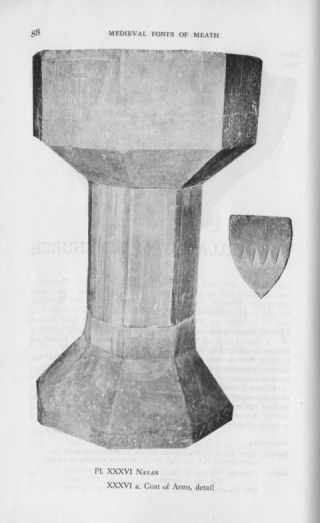
The font (left) is octagonal, with its sides of
10 1/2 inches, the interior of the bowl
having a flat bottom with a drainage
hole in the centre.
It bears shields on two oposite sides,
the one transversed by a zigzag
line, and the other having a cross
and the roughly inscribed words
" In hoc signo vinces 1716."
an earlier date than the inscription.
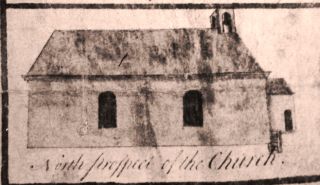 ( left) A drawing of it on the 1756 map
( left) A drawing of it on the 1756 map
by Thomas Williams
shows a plain low building, with
two windows on the north side, a
little bell turret on the west gable,
and a low porch at the west end reached by a flight of steps.
The drawing was copied by J.H. Moore, Meath County Surveyor, into his book of inscriptions in Navan Church and Churchyard, 1888. The map, which cannot now be located, was made for the co-heirs of Lord Ranelagh, and was formerly in the possession of the Earl of Essex (Moore, "Notices of the Town of Navan," Journal Royal Society Antiquaries Ireland 1893-94).
In 1766 the walls were raised by 18 1/2 feet, the building re-roofed, and interior galleries added. The erection of the Tower was begun in 1760 to the plans of Edward Morgan and Robert Price, masons, but it was not finished until 1813.
Richard Dansey was paid £1-15-0 compensation for the building of the tower on part of his garden, the necessary sand being obtained from his adjoining sandpit. He was the town scavanger, and also controlled the town pump, lamps and fire fighting equipment.
Joseph Preston, M.P., gave a bell to the Corporation in 1768, and this was presented to the Church, the old one being sold in order to buy a new pulpit. The present bell, dated 1822, was made by William Dobson at Downham, in Norfolk, and there is a smaller one, dated 1819, now disused. The clock was installed in 1823, and a Mr. Robert Russell was appointed caretaker of it at a salary of £3 a year. It has served the town ever since, and the only time it needed major repairs was in 1935, when the winding pinions were removed. It was elecrically illuminated in 1927 by the Urban Council, which body has regulated it for many years.
Before the Tower existed, the timekeeper had been a sundial given by Dixie Coddington in 1757. There was, however, a Corporation clock in the 18th century, since Thomas McAllister was to receive £8 arrears of salary, as Marshall Keeper, and for taking care of the clock, under a Corporation order of 19th September 1773.
Between 1815 and 1818 the Church was rebuilt at a cost of £1,569-4-7 1/4. The nave was widened, and the front porch, and vestry were added. This " handsome stone building," as an 1819 Directory describes it, is outwardly almost unchanged today, though the interior has been considerably modernised.
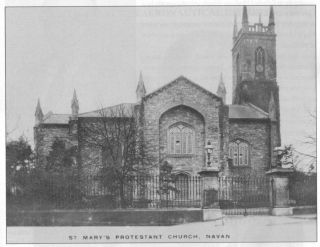
The plans for the reconstruction, some of which are still preserved, were drawn up by the
Rev. Daniel Augustus Beaufort, 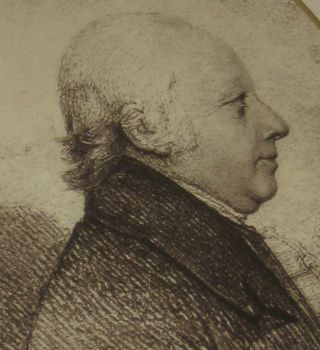
Rector of Navan, (left) 1765-1818.
He was Vicar of Collon from 1790 until
his death in 1821,
and built the church there also.
A noted scholar, and author of a number of educational works,
he was one of the founders of the Royal Irish Academy.
In 1792 he published an entirely new Map of Ireland, with a " Memoir on the Civil and Eccesiastical state of the Country", and also a Parish Map of the Meath Diocese in 1816.
He was descended from the ancient French family of de Beaufort, the Protestant branch of which had fled from the Paris region to Sedan at the time of the Massacre of St. Bartholomew.
William Morris Beaufort," The Family of de Beaufort in France, Holland, Germany and England. Printed for private circulation, London 1886."
His grandfather, a diplomat and soldier, emigrated to Prussia on the Revocation of the Edict of Nantes in 1685. His father Cornelius served in the Prussian army, but later after a period of study at Utrecht University became a Minister to the Huguenot colony in London. After taking Anglican orders, he was appointed Rector of East Barnet, and later came to Ireland as Chaplin to Lord Harrington.He received the benefice of Navan in 1747, but resigned in favour of his son in 1765.
What is perhaps a bit of current gossip about him is noted by Dr. C. Maxwell in "Country and Town in Ireland under the Georges," page 327.
"An ancient French dancing master came over with the late Duke of Devonshire, and though he could not read one word of English he was thrust into Orders, and was inducted into the living of Navan."
( From a letter written to Derrick in 1763 by his friend Dr. Wilson of Trinity College Dublin.)
Dr. D.A. Beaufort married Mary Waller of Allenstown, and for some years lived on Flower Hill, where in May 1774, Francis, the younger of his two sons was born.
Francis Beaufort went to sea at the age of 13, and shortly after entered the Royal Navy. He served with distinction during the Napoleonic Wars, in one action alone receiving 19 wounds. While recuperating from these he assisted his brother in law, R. L. Edgeworth, in constructing a semaphore telegraph system, whereby messages could be transmitted from Dublin to Galway in 8 minutes.
Transactions of the Royal Irish Academy, Volume VI, page 95.
In 1809 he received his first command, and during the next few years carried out a survey of the Turkish coast, his account of which, published in 1817,became one of the first popular travel books. From 1829-55 he was Hyrographer to the Admiralty.
He attained flag rank in 1846, and was knighted in 1848. His skill in mapping the earth's surface, both above and below water, was such that his drawings could immediately be made into copper plates for printing. For years he worked from 5 to 8 a.m. on his labour of love, an atlas of the world, before going to his job at the Admiralty. The work of this remarkable man still endures today, his scale of wind forces still being in use, while the Beaufort Sea, north of Alaska, and a number of other places are named after him. He was also interested in the art of Cryptography and invented a new system of coding messages.
Sir William Wilde wrote "He was a gallant sailor and a cordial friend. He very nearly induced me in 1840 to give up medicine and become Secretary of the Geographical Society."
Footnote to "Memoir of Gabriel Beranger," Journal Royal Society Antiquaries Ireland 1870.
Admiral Beaufort was a fellow or member of many learned societies including the Royal Society and the Royal Irish Academy. His portrait hangs in the National Maritime Museum at Greenwich, and the Royal Navy still awards an annual Beaufort Memorial Prize in navigation, while his former London residence, 51 Manchester Street, is marked by a memorial plaque.
Admiral Beaufort's eldest sister Frances (born at Flower Hill 1769) married the remarkable genius, R.L. Edgeworth in 1798, and notwithstanding the disturbed state of the country, drove with him at once from Dublin to Edgeworthstown. Two of his other sisters were authoresses. The youngest, Louisa, attained distinction by writing an essay on "Irish Architecture prior to the Anglo Norman Conquest," which was published in The Proceedings of the Royal Irish Academy.
R.L. Edgeworth's sister, Margaret, was married to John Ruxton of Blackcastle, and it was there that Edgeworth and Beaufort families became acquainted. Later at Collon, where Dr. Beaufort had become Vicar and now resided, Edgeworth saw and critised some sketches made by Fanny Beaufort, an accomplished artist, for "The Parents' Assistant," one of his daughter's Maria educational works.
And when the Beaufort family visited Edgeworthstown early in 1798, he saw that Miss Beaufort "possessed exactly the temper, abilities, and disposition, which would ensure the happiness of his family as well as his own,if he could hope to win her affections."
He lost no time in asking for her hand,and was accepted. "I am going to be married," he wrote to a friend of his, " to a young lady of small fortune and large accomplishments; compared with my age much youth ( not quite 30) and more prudence; some beauty, more sense; uncommon talents, more uncommon temper; liked by my family, loved by me. If I can say all this three years hence, shall I not have been a fortunate, not to say a wise man?"
"Memoirs of Richard Lovell Edgeworth," Volume 2.
His wisdom and good fortune were proved by the outstanding success of this his fourth marriage. "Miss Beaufort proved a perfect helpmate, and never can a fourth wife have presided over a happier or a more united household. Maria herself became the nearest and dearest of all her friends, and her step children loved her scarcely less than her own."
The Black Book of Edgeworthstown and other Edgeworth memories, 1585-1817, Editors Harriet Jessie Butler and Harold Edgeworth Butler, 1927.
"Besides being sensible, she was pleasing to look at, with sea green eyes, russet locks, serene expression, and a small trim figure."
Elizabeth Inglis Jones, "The Great Maria."
Her second daughter, Harriet, married Dean Butler, the Historian of Trim,"a good and learned man, and a delightful talker; to listen to him in conversation with Maria was a treat, so admirable was the play of their minds."
The Black Book of Edgeworthstown and other Edgeworth memories, 1585-1817, Editors Harriet Jessie Butler and Harold Edgeworth Butler, 1927.
Harriet Butler evidently inherited in full measure the Beaufort Edgeworth thirst for knowledge. We are told that in her later years she used to rise at 5 a.m. to read books in many languages, including Greek and Spanish;and that she read the whole of Shakespeare's and Scott's every year .The relationships of the two families became even closer and more complex, when Admiral Sir Francis Beaufort took as his second wife Honora, a daughter of R.L. Edgeworth, by his third wife, Elizabeth Sneyd. Thus he became both son in law and brother in law to Edgeworth!
The vestry Minute Books of Navan Church date back to 1750, and beside containing matters of purely Church interest, yield a good deal of information about conditions and personalities in the neighbourhood, and the owners of land and property in the 18th and 19th centuries. They also contain accounts, which reveal the level of wages and prices in those days. Up to 1827 one of the principal duties of the Vestry was to levy a cess on all land in the Parish for the repairs of the Church, and the payment of Parish officers. Church Tithes were introduced in the 12th century. They caused endless turmoil, and after the tithe wars of the eighteen thirties they were replaced by a charge payable by owners, rather than tenants of land.
The Vestry also had to provide many of the Public Services, which later fell on Poor Law Guardians, Urban Councils, and other bodies. These included the repair of roads, lighting of streets, caring for the destitute and insane, making provision for foundlings, appointing Officers of Health and Night Watchmen.
For example, in 1750 and 1751 the Six Days Labour required of the Parish, under an Act of James 1, was to be employed in "repairing and making a foot or path way from the Bridge of Navan to the Bush, commonly called Tuke's Bush; and the road from John Millburn's (house) to the upward end of the Commons of Navan; and the road leading from Millburn's said house to the lands of Knockumber; and the road from Kilcarn Turnpike to Trim, ending at the turn to Mr. Ludlow's " (Ardsallagh). In 1766 it was ordered that "each house within the walls and as far as Nicholas Byrne's do pay 3d. in the pound of the rent of their houses for lighting and gravelling the streets in aid of the money allocated by the Corporation for these purposes."
In 1761 there was a Francis Tuke living in Dublingate Street and a John Tuke in Trimgate Street. Possibly " Tuke's Bush" means " Tuke's Tavern."
An ivy bush was the common sign of taverns, and especially of private houses where beer or wine could be obtained by travellers... ivy being sacred to Bacchus."
Brewer, Dictionary of Phrase and Fable.
The following year "a valuation was made of the houses in Navan and entered in a book, according to which a cess was laid on for repairing the streets pursuant to Act of Parliament".
In 1819 Officers of Health, appointed under an Act of George lll to establish regulations for preventing contagious diseases, including the Rector, Curate, Churchwardens, and Doctors John Browne and Peter Gilroy,the resident physicians. While in 1825 John Doak, Dawson Thompson Jr., and Phillip Plunkett of Navan, and members of the Constabulary, were appointed overseers of persons and houses licensed for the sale of spirituous and other liqours.
Other townsmen of this period were Thomas Gerrard, Publican; James Byrne and John McCann, Millers; William Blake, Patrick and Nicholas Delaney, Sam Wakefeld and Peter Commons, Carpenters; John McNally, Cooper; Robert Wiggins, Builder; Mulligan, Tailor; Doogan, Slater; Daniel Montague, Mason; Richard Eason and James Monaghan, Painters.
Among the occupiers of land appearing in the tithe lists were the Right Reverend Dr. Plunkett (15 acres) and his Curate, the Reverend Eugene O'Reilly (25 acres). There were 21 holdings of over 50 acres, but in general they ranged from 3 to20 acres.
The accounts show that in 1800 a greatcoat cost £1-14-1 1/2, a suit of clothes £3, coal 4 shillings per barrel, candles 11 pence per dozen, turf 9 pence a sack, and coffins 6 shillings and 8 pence to 11 shillings. A mason was paid 2 shillings 2 pence per day for work on the tower, while the sexton received 2 shillings for "extraordinary sweeping of the Church" for the Bishop's Visitation, and Robert Noble, the grave digger 2 shillings and 2 pence for "taking up ye hanged man buried in the Churchyard, liquor..." Town and Church officials often received a uniform or coat in addition to their wages.
In 1805, the sexton, whose salary was £5 per year, wore "a wide coat of strong blue cloth, with a large scarlet cape and gilt buttons."
Between 1878 and 1890 the old box pews and the west gallery were removed from the Church, and a reredos (ornamental screen covering wall at the back of the altar) and three stained glass windows installed. The area in front of the Church, formerly used for cattle markets, was levelled and railed in.
Source: Ríocht na Midhe 1963, Vol. 3. Photos uploaded by N&DHS
*******
Irish Times, 14 March 1860, Newspaper Report:
The Lord Bishop of Meath purposes to hold a general Ordination in the Parish Church of Ardbraccan in the month of June next. Candidates for ordination will forward their applications by post to the Lord Bishop's of Meath secretary, Ardbraccan House, Navan.
The Times, 27 June 1863 ~ Newspaper Report regarding the status Church of Ireland
In the town of Navan the value of the living is £566 per annum, the church accommodation is for 200 persons, and the number of Protestants is only 154.
*******
St. Mary's Church of Ireland Church Tower
In 1759 it was decided to build a steeple, and a plan by Edward Morgan and Robert Price, masons, was submitted. A committee was appointed to superintend the work.
In 1764 Edward Morgan got a bonus of £3-3-0 for his extraordinary care in building the steeple. It was proposed to build a spur on the new Tower or Steeple, but was not proceeded with.
In 1804 the boarded covering on top of the Tower was repaired for a temporary protection " as it is expected that the Steeple shall be finished this summer,either by subscription for ornamenting it or by a plain roof."
In 1807, £60 was expended on the four great windowns of the Belfry and the outer door and for roofing in the Belfry. In 1811 £20 was required for staunching and completing the Steeple. In 1823 the Bell and Clock were put up.
The Clock was originally at a lower level but was moved up so as to be visible over a larger area. In 1896 one of the pinnacles of the Tower was struck by lightning and fell through the roof of the church.
In the 1920s the Clock which had supplied the time to the inhabitants of Navan for over one hundred years, ceased to function and was sadly missed. Great was the satisfaction of the people when it was restarted and illuminated by electric light. The idea of having the dial visible by night was suggested by Joseph Cooke, Chairman of Navan Urban District Council and the Urban Council undertook the necessary work. From time immemorial, the the authorities of the town of Navan have paid for the winding of the clock. In the 1930s it became necessary to repair the upper portion of the Tower, which was begun in 1759 and added to at various times since that date.
T.W. Pyper, Honorary Treasurer of a Fund Raising Committee in the 1930s.
The Tower Fete was held in Navan Show Grounds (now Navan O'Mahonys ) on Thursday 11th June 1931. Navan shops closed for a half day on Thursdays. T.W. Pyper was Manager of The Royal Bank, Navan, where Excel Print is now, in Bedford Place. He was Captain of Bellinter Golf Club (now Royal Tara ) in 1935.
*******
St. Mary's Church of Ireland Clock (1983)
By Liam Hayes
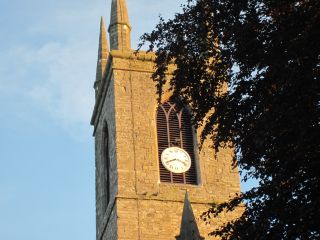
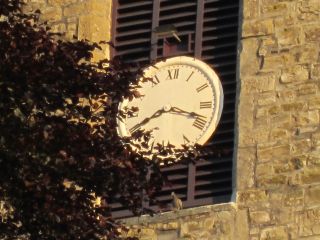
Since 1823 time has been measured smoothly by the clock on the tower of St. Mary’s Church of Ireland, Navan. Now all of that, as well as the clock, has stopped.
The time-piece has been silent for seven weeks. It was last wound on the 3rd February but the hands since stopped at 5.07 – a time which has become familiar to passersby and especially to Rev. Canon J.A.G. Barrett, Rector, Navan.
On Tuesday night at their annual preliminary estimates meeting the local urban councillors attempted to rectify the situation and the dispute over payment which has arisen with jewellers Alfred and Liam Walsh, Watergate Street, Navan.
The Walsh family have been maintaining the clock for about 150 years and during this period they have enjoyed a happy relationship with the council. However, the “knives” of the recession caused the council to look carefully at their expenditure and among other things their gaze switched high in the air to St. Mary’s Church clock.
The Walsh brothers said that during those 150 years the clock has never before been stopped because of a dispute. Alfred said: “I feel sad that the people have been inconvenienced because they have been using it over the years. We would take up the contract where we left off, but it is entirely a matter for the councilors at their estimates meeting.”
They agree that the dispute, which also concerns the maintenance of a clock over their premises in Watergate Street, is unusual and feel that “tradition has been broken” by this happening. The clock has to be wound once a week at least and there is plenty of labour involved in the task. “The key of the clock is like the starting handle of an old car,” added Alfred.
He concluded: “It’s a job for a qualified person, but we have been very happy and have had a good relationship with both the cCouncil and the Church Body over the years.”
Canon Barrett said that many people driving and walking past the Church and going onto the Fair Green use the clock as a time check. Both clocks are recognized as the “town clocks” and their importance goes back to the old days when not so many people had watches. He added that the clock was erected with the bell in 1823, but that the steeple dates back further.
*******
Roger Puttock was appointed vicar of Donaghmore immediately after receiving his MA in 1622. In 1632, in his dedication to a controversial work, ”A rejoinder unto Friar Malone”, he called upon the incoming lord deputy, Viscount Wentworth, to root out Catholicism by force. In the following year he was appointed rector of Navan. He later related that “ the very first night after this rebellion was knowne generally all papists houses at Navan were sett upon a merry pin, dancing singing, anddrinking as if hell had bin broken upon among them.“ After he protested against the portreeve’s failure to take steps to defend the town, Puttock was shot at on 25 October and subsequently fled in disguise with his wife and two children, leaving a third behind. His possessions were taken, according to a parishioner, “by all and singular the inhabitants of Navan who shared the said Roger’s goods among them."
Reshaping Ireland 1550-1700, Brian Mac Cuarta SJ Editor. page 243.
*******